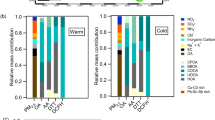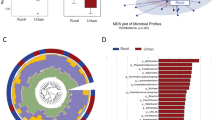Abstract
Among a health cooperation project, we had the opportunity to study the internal polycyclic aromatic hydrocarbon (PAH) exposure of residents from urban and rural areas in Afghanistan. Urine samples from 13 children (age 2.0–9 years) and 42 adults (age 20–65 years) were collected. A total of 25 participants were from Kabul, and 30 participants lived in a rural area. The determination of 1-hydroxypyrene and hydroxyphenanthrenes was carried out by high performance liquid chromatography and fluorescence detection. Median (range) were as follows (n=55): 1-hydroxypyrene 1646 ng/l (71–16,288 ng/l) and sum of 1-, 2- and 9-, 3-, 4-OH-phenanthrenes 3602 ng/l (116–19,670 ng/l). These results indicate a high PAH exposure, compared with the general population in more developed countries. The levels of 1-hydroxypyrene in urine of women (all non-smokers) from the rural area were higher than those from Kabul (N, median, range): rural 15, 2095, 334–11,357 ng/l; Kabul 11, 748,137–5332 ng/l. All households from the rural area used open fires for cooking and energy. We conclude that populations in low-developed countries may be at special risk to increased PAH exposure due to inadequate control of air pollution from car emissions and due to burning of biomass fuels for cooking and household energy.
This is a preview of subscription content, access via your institution
Access options
Subscribe to this journal
Receive 6 print issues and online access
$259.00 per year
only $43.17 per issue
Buy this article
- Purchase on Springer Link
- Instant access to full article PDF
Prices may be subject to local taxes which are calculated during checkout
Similar content being viewed by others
References
Albalak R., Bruce N., McCracken J.P., Smith K.R., and DeGallardo T. Indoor respirable particulate matter concentrations from an open fire, improved cookstove, and LPG/open fire combination in a rural Guatemalan community. Environ Sci Technol 2001: 35: 2650–2655.
Angerer J., Ewers U., and Wilhelm M. Human biomonitoring: state of the art. Int J Hyg Environ Health 2007: 210: 201–228.
ATSDR (Agency for Toxic Substances and Disease Registry). 1995 Toxicological profile for polycyclic aromatic hydrocarbons. U.S. Department of Health and Human Services. Public Health Service, Agency for Toxic Substances and Disease Registry. http://www.atsdr.cdc.gov/ToxProfiles/TP.asp?id=122&tid=25.
Balakrishnan K., Sankar S., Parikh J., Padmavathi R., Srividya K., Venugopal V., Prasad S., and Pandey V.L. Daily average exposures to respirable particulate matter from combustion of biomass fuels in rural households of southern India. Environ Health Perspect 2002: 110: 1069–1075.
Becker K., Schulz C., Kaus S., Seiwert M., and Seifert B. German Environmental Survey 1998 (GerES III): environmental pollutants in the urine of the German population. Int J Hyg Environ Health 2003: 206: 15–24.
CDC. Fourth National Report on Human Exposure to Environmental Chemicals. Atlanta, GA, USA, 2009.
Cobb C., Ward K.D., Maziak W., Shihadeh A.L., and Eissenberg T. Waterpipe tobacco smoking: an emerging health crisis in the United States. Am J Health Behav 2010: 34: 275–285.
Daher N., Saleh R., Jaroudi E., Sheheitli H., Badr T., Sepetdjian E., Al Rashidi M., Saliba N., and Shihadeh A. Comparison of carcinogen, carbon monoxide, and ultrafine particle emissions from narghile waterpipe and cigarette smoking: Sidestream smoke measurements and assessment of second-hand smoke emission factors. Atmos Environ 2010: 44: 8–14.
DFG. PAH metabolites (1-hydroxyphenanthrene, 4-hydroxyphenanthrene, 9-hydroxyphenanthrene, 1-hydroxypyrene)—determination in urine. In: Commission for the Investigation of Health Hazards of Chemical Compounds in the Work Area, (Ed.). Analyses of Hazardous Substances in Biological Materials: WILEY-VCH, Weinheim, 1999, pp. 163–187.
Dherani M. Indoor air pollution due to biomass fuels in north India. T Roy Soc Trop Med H 2003: 97: 626–626.
EFSA (European Food Safey Authority). Polycyclic aromatic hydrocarbons in food. Scientific Opinion of the Panel on Contaminants in the Food Chain. EFSA J 2008: 724: 111–114.
Eissenberg T., and Shihadeh A. Waterpipe tobacco and cigarette smoking: direct comparison of toxicant exposure. Am J Prev Med 2009: 37: 518–523.
Hansen A.M., Mathiesen L., Pedersen M., and Knudsen L.E. Urinary 1-hydroxypyrene (1-HP) in environmental and occupational studies--a review. Int J Hyg Environ Health 2008: 211: 471–503.
Haufroid V., and Lison D. Urinary cotinine as a tobacco-smoke exposure index: a minireview. Int Arch Occup Environ Health 1998: 71: 162–168.
Hemat H., Wilhelm M., Völkel W., Mosch C., Fromme H., and Wittsiepe J. Low serum levels of perfluorooctanoic acid (PFOA), perfluorooctane sulfonate (PFOS) and perfluorohexane sulfonate (PFHxS) in children and adults from Afghanistan. Sci Total Environ 2010: 408: 3493–3495.
IARC Smokeless tobacco and tobacco-specific nitrosamines. IARC Monographs on the Evaluation of Carcinogenic Risks to Humans. IARC, Lyon, France. 2007.
IARC Household use of solid fuels and high-temperature frying. IARC Monographs on the Evaluation of Carcinogenic Risks to Humans. IARC, Lyon, France 2010.
Kallen K. The impact of maternal smoking during pregnancy on delivery outcome. Eur J Public Health 2001: 11: 329–333.
Kirchengast S., and Hartmann B. Nicotine consumption before and during pregnancy affects not only newborn size but also birth modus. J Biosoc Sci 2003: 35: 175–188.
Knishkowy B., and Amitai Y. Water-pipe (narghile) smoking: an emerging health risk behavior. Pediatrics 2005: 116: e113–119.
Li Z., Sandau C.D., Romanoff L.C., Caudill S.P., Sjodin A., Needham L.L., and Patterson D.G. Jr. Concentration and profile of 22 urinary polycyclic aromatic hydrocarbon metabolites in the US population. Environ Res 2008: 107: 320–331.
Mirahmadizadeh A., and Nakhaee N. Prevalence of waterpipe smoking among rural pregnant women in Southern Iran. Med Princ Pract 2008: 17: 435–439.
Mumford J.L., Li X., Hu F., Lu X.B., and Chuang J.C. Human exposure and dosimetry of polycyclic aromatic hydrocarbons in urine from Xuan Wei, China with high lung cancer mortality associated with exposure to unvented coal smoke. Carcinogenesis 1995: 16: 3031–3036.
Naeher L.P., Brauer M., Lipsett M., Zelikoff J.T., Simpson C.D., Koenig J.Q., and Smith K.R. Woodsmoke health effects: a review. Inhal Toxicol 2007: 19: 67–106.
Pearce J.L., Aguilar-Villalobos M., Rathbun S.L., and Naeher L.P. Residential exposures to PM2.5 and CO in Cusco, a high-altitude city in the Peruvian Andes: a pilot study. Arch Environ Occup Health 2009: 64: 278–282.
Pokhrel A.K., Bates M.N., Verma S.C., Joshi H.S., Sreeramareddy C.T., and Smith K.R. Tuberculosis and indoor biomass and kerosene use in Nepal: a case-control study. Environ Health Perspect 2010: 118: 558–564.
Pope D.P., Mishra V., Thompson L., Siddiqui A.R., Rehfuess E.A., Weber M., and Bruce N.G. Risk of low birth weight and stillbirth associated with indoor air pollution from solid fuel use in developing countries. Epidemiol Rev 2010: 32: 70–81.
Radwan G.N., Mohamed M.K., El-Setouhy M., and Israel E. Review on water pipe smoking. J Egypt Soc Parasitol 2003: 33: 1051–1071.
Rehfuess E., Mehta S., and Pruss-Ustun A. Assessing household solid fuel use: multiple implications for the Millennium Development Goals. Environ Health Perspect 2006: 114: 373–378.
Rossbach B., Preuss R., Letzel S., Drexler H., and Angerer J. Biological monitoring of occupational exposure to polycyclic aromatic hydrocarbons (PAH) by determination of monohydroxylated metabolites of phenanthrene and pyrene in urine. Int Arch Occup Environ Health 2007: 81: 221–229.
Rustemeier K., Demetriou D., Schepers G., and Voncken P. High-performance liquid chromatographic determination of nicotine and its urinary metabolites via their 1,3-diethyl-2-thiobarbituric acid derivatives. J Chromatogr 1993: 613: 95–103.
Schulz C., Angerer J., Ewers U., Heudorf U., and Wilhelm M. Revised and new reference values for environmental pollutants in urine or blood of children in Germany derived from the German environmental survey on children 2003–2006 (GerES IV). Int J Hyg Environ Health 2009: 212: 637–647.
Sepetdjian E., Saliba N., and Shihadeh A. Carcinogenic PAH in waterpipe charcoal products. Food Chem Toxicol 2010: 48: 3242–3245.
Sepetdjian E., Shihadeh A., and Saliba N.A. Measurement of 16 polycyclic aromatic hydrocarbons in narghile waterpipe tobacco smoke. Food Chem Toxicol 2008: 46: 1582–1590.
Shihadeh A., Azar S., Antonios C., and Haddad A. Towards a topographical model of narghile water-pipe cafe smoking: a pilot study in a high socioeconomic status neighborhood of Beirut, Lebanon. Pharmacol Biochem Behav 2004: 79: 75–82.
Smith K.R., Mehta S., and Mäusezahl-Feuz M. Indoor air pollution from household use of solid fuels. In: Ezzati, M., Lopez, A.D., Rodgers, A., Murray, C.J.L. (Eds.). Comparative Quantification of Health Risks: Global and Regional Burden of Disease Attributable to Selected Major Risk Factors. WHO (World Health Organization), Geneva, Switzerland, 2004 pp. 1435–1493.
Stepanov I., Jensen J., Hatsukami D., and Hecht S.S. New and traditional smokeless tobacco: comparison of toxicant and carcinogen levels. Nicotine Tob Res 2008: 10: 1773–1782.
Straif K., Baan R., Grosse Y., Secretan B., El Ghissassi F., and Cogliano V. Carcinogenicity of polycyclic aromatic hydrocarbons. Lancet Oncol 2005: 6: 931–932.
Taussky H.H. A microcolorimetric determination of creatine in urine by the Jaffe reaction. J Biol Chem 1954: 208: 853–861.
Tielsch J.M., Katz J., Thulasiraj R.D., Coles C.L., Sheeladevi S., Yanik E.L., and Rahmathullah L. Exposure to indoor biomass fuel and tobacco smoke and risk of adverse reproductive outcomes, mortality, respiratory morbidity and growth among newborn infants in south India. Int J Epidemiol 2009: 38: 1351–1363.
Van Rooij J.G.M., Veeger M.S., Bodelier-Bade M.M., Scheepers P.T.J., and Jongeneelen F.J. Smoking and dietary intake of polycyclic aromatic hydrocarbons as sources of interindividual variability in the baseline excretion of 1-hydroxypyrene in urine. Int Arch Occup Environ Health 1994: 66: 55–65.
WHO/IPCS (World Health Organization/International Programme on Chemical Safety) Selected Non-heterocyclic Polycyclic Aromatic Hydrocarbons. Enviroenmental Health Criteria 202. Internationals Programme on Chemical Safety, WHO, Geneva 1998.
WHO Tobacco Free Initiative, Advisory Note. Waterpipe Tobacco Smoking: Health Effects, Research Needs and Recommended Actions by Regulators 2005.
Wilhelm M., Hardt J., Schulz C., and Angerer J. New reference value and the background exposure for the PAH metabolites 1-hydroxypyrene and 1- and 2-naphthol in urine of the general population in Germany: basis for validation of human biomonitoring data in environmental medicine. Int J Hyg Environ Health 2008: 211: 447–453.
Acknowledgements
We would like to thank all participants that took part in this study. We also acknowledge the important contributions of Sayed Mohammad Amin Fatemi, Shahmahmood Miakhel, Basheer Noormal, Jochen Scheld, André Schütze, Mrs. Nasreen Oriakhel, Khushal Tasal, Ashraf Shinwary, Mrs. Natasha, for their support to this study by their assistance.
Author information
Authors and Affiliations
Corresponding author
Ethics declarations
Competing interests
The authors declare no conflict of interest.
Rights and permissions
About this article
Cite this article
Hemat, H., Wittsiepe, J., Wilhelm, M. et al. High levels of 1-hydroxypyrene and hydroxyphenanthrenes in urine of children and adults from Afghanistan. J Expo Sci Environ Epidemiol 22, 46–51 (2012). https://doi.org/10.1038/jes.2011.33
Received:
Accepted:
Published:
Issue Date:
DOI: https://doi.org/10.1038/jes.2011.33
Keywords
This article is cited by
-
Non-carcinogenic and cumulative risk assessment of exposure of kitchen workers in restaurants and local residents in the vicinity of polycyclic aromatic hydrocarbons
Scientific Reports (2023)
-
Association of polycyclic aromatic hydrocarbon metabolite concentration in urine and occupational stress in underground coal miners in China: propensity score and bayesian kernel machine regression
Environmental Science and Pollution Research (2023)
-
Human biomonitoring and reference values of urinary 1-hydroxypyrene among Iranian adults population
Environmental Science and Pollution Research (2023)
-
Biomarkers for polycyclic aromatic hydrocarbons in human excreta: recent advances in analytical techniques—a review
Environmental Geochemistry and Health (2023)
-
Health risk assessment of polycyclic aromatic hydrocarbons in individuals living near restaurants: a cross-sectional study in Shiraz, Iran
Scientific Reports (2022)



